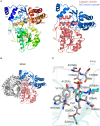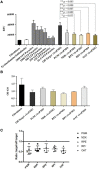CSGID Solves Structures and Identifies Phenotypes for Five Enzymes in Toxoplasma gondii
- PMID: 30345257
- PMCID: PMC6182094
- DOI: 10.3389/fcimb.2018.00352
CSGID Solves Structures and Identifies Phenotypes for Five Enzymes in Toxoplasma gondii
Abstract
Toxoplasma gondii, an Apicomplexan parasite, causes significant morbidity and mortality, including severe disease in immunocompromised hosts and devastating congenital disease, with no effective treatment for the bradyzoite stage. To address this, we used the Tropical Disease Research database, crystallography, molecular modeling, and antisense to identify and characterize a range of potential therapeutic targets for toxoplasmosis. Phosphoglycerate mutase II (PGMII), nucleoside diphosphate kinase (NDK), ribulose phosphate 3-epimerase (RPE), ribose-5-phosphate isomerase (RPI), and ornithine aminotransferase (OAT) were structurally characterized. Crystallography revealed insights into the overall structure, protein oligomeric states and molecular details of active sites important for ligand recognition. Literature and molecular modeling suggested potential inhibitors and druggability. The targets were further studied with vivoPMO to interrupt enzyme synthesis, identifying the targets as potentially important to parasitic replication and, therefore, of therapeutic interest. Targeted vivoPMO resulted in statistically significant perturbation of parasite replication without concomitant host cell toxicity, consistent with a previous CRISPR/Cas9 screen showing PGM, RPE, and RPI contribute to parasite fitness. PGM, RPE, and RPI have the greatest promise for affecting replication in tachyzoites. These targets are shared between other medically important parasites and may have wider therapeutic potential.
Keywords: PPMO; Toxoplasma gondii; crystallography; nucleoside diphoshate kinase; ornithine aminotransferase; phosphoglycerate mutase; ribose-5-phosphate isomerase; ribulose-3-phosphate epimerase.
Figures










References
-
- Akana J., Fedorov A. A., Fedorov E., Novak W. R. P., Babbitt P. C., Almo S. C., et al. (2006). D-Ribulose 5-phosphate 3-epimerase: functional and structural relationships to members of the ribulose-phosphate binding (beta/alpha)8-barrel superfamily. Biochemistry 45, 2493–2503. 10.1021/bi052474m - DOI - PubMed
Publication types
MeSH terms
Substances
Grants and funding
LinkOut - more resources
Full Text Sources

